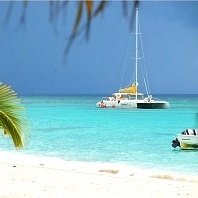What is coral bleaching?
A Desert of White Skeletons

 Remnants of Coral Skeletons
Remnants of Coral Skeletons
If you ever snorkeled through a bleached reef, you know how depressing this is. A colorful oasis, filled to the brim with all forms of life who depend on one another to survive is being reduced to a desert of white skeletons.
Coral Bleaching Before & After

A Match made 210 Million Years Ago
Corals are usually partially covered in algae. And while we see algae in many other places, corals and algae actually have a symbiotic relationship. In other words, they depend on each other to survive. According to a somewhat recent study conducted by researchers from Princeton University, this symbiotic relationship began more than 210 million years ago.
Corals and Algae Nourish and Protect One Another
All those years ago there was a massive worldwide expansion of coral-reefs, which suggests that algae' and corals' symbiosis is crucial to the health of coral reefs. Corals provide habitat to a quarter of all marine life and while corals are not able to perform photosynthesis, algae do. As such, they give photosynthates to the corals. In return, the algae gets CO2 and protection from grazing marine animals. Additionally, the algae also provide pigments to a coral's white skeleton to protect it from the ruthless sunlight. Ultimately, we can say that corals and algae nourish and protect one another.
Seeing how coral bleaching removes a coral's pigment leaving a white skeleton and reading about the algae supply of pigments to corals, it is easy to pinpoint the cause of coral bleaching. The disappearance of its BFF, algae.
Bleaching of a Brain Coral

Corals Might Never Recover
When the environment surrounding the coral changes for the worse, the coral's ability to provide for the algae is remarkably inhibited. To ensure short-term survival, the coral will actually expel the algae. As a result, the corals will become pale and slowly begin to starve. The decision to dismiss the coral enables corals to survive short-term disturbances, but chronic disorders such as the ones caused by global warming will make it impossible for the coral to recover.
But What Exactly Causes Algae to Leave the Coral?
Algae is a susceptible organism, and while it boasts an incredibly photosynthetic efficiency, all the conditions need to be just right so it can thrive. Minor changes to the environment can have far-reaching effects on areas depending on algae in one way or another. The list of potential triggers for coral bleaching is massive:
These are just some of the many problems our pristine, beloved corals have to deal with. And as humans, we should be embarrassed, that almost all of these are triggers set by us in one way or another. While coral reefs can recover, the process is prolonged and the colorful organisms living in them, who bring joy to many curious tourists, may never recover at all.
Regarding our previous post about sunscreen
While our last post talked about the potential severity of going snorkeling with sunscreen that is not safe for reefs. It is essential to point out that Oxybenzone is not the only culprit here. There are other sunscreen ingredients, that are not biodegradable, wash off the skin, and are thus considered pollutants with the potential to kill corals. Namely, Butylparaben, Octyl Methoxycinnamate, and Enzacamene.
In Conclusion... It's a Complex Issue
These marine ecosystems have evolved over millions of years, finding solutions to problems through mutation and survival of the fittest. For us to help these systems recover, we first have to understand the issues. We don't know for sure if we (humans) are the main cause of Coral Bleaching, but we know what we can do to slow down the process.
Step 1: Parttake in Sustainable Tourism
SeavisTours is voted one of the best Saona Island excursions by independent reviewers on Tripadvisor. The tour is focused on smaller groups with professional European guiding. SeavisTours is one of the few Ecotourism companies in the Dominican Republic dedicated to the preservation of Saona Island and it's surrounding marine sanctuary. If you're going to the Dominican Republic and want to lower your footprint while on vacation, join them on their Saona Crusoe VIP excursion.
Review Saona Crusoe VIP

SeavisTours also has a sea turtle sanctuary on the island and you might be able to see a 2 day old turtle. Check out Seavis Tours and you will not be disappointed.

















